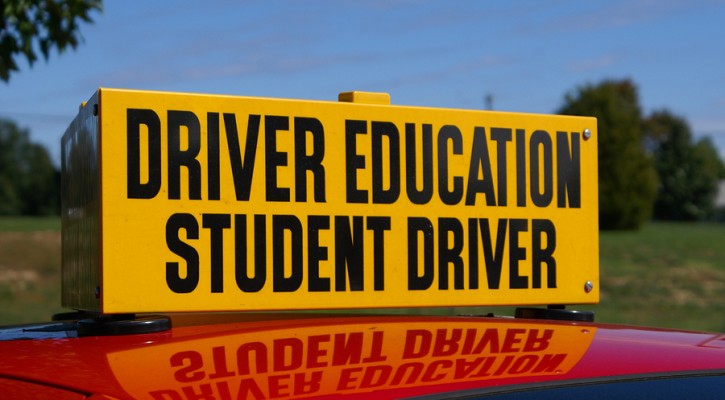Tag Archive: drivers ed

Teens With Drivers Ed Have Fewer Crashes and Tickets
September 12, 2014
Teens who complete Drivers Ed (DE) have fewer crashes and receive fewer traffic tickets than teens who don’t complete a drivers ed program according to a study published by the AAA Foundation. The difference between DE and non-DE teens, while small, are still statistically significant according to the researchers.
The study looked at a large number of teen drivers in the Province of Manitoba Canada and the State of Oregon. To determine a baseline, the studies surveyed teens who planned to take drivers ed and those who didn’t. Afterwards, they followed up with additional surveys, and performances in driver simulations. They also looked at scores on the driver’s exam and driving records.
In Oregon, the study compared the driving records of a total of 94,342 DE and non-DE teen drivers and found:
- DE teens had significantly fewer crashes than non-DE teens over the first 18 months of independent driving.*
- DE teens had 4.3% fewer crashes than non-DE teens during the entire period of the study.
- DE teens had significantly fewer convictions for traffic offenses than non-DE teens during the first 18 months of independent driving.*
- DE teens had 39.3% fewer convictions for traffic offenses than non-DE teens during the entire period of the study.
* Teenagers’ crash and near-crash rates were nearly 4 times the rates of adults during the 18 months following licensure. (Insurance Institute for Highway Safety)
In both Oregon and Manitoba, the researchers found that:
- DE teens had a slightly better knowledge of safe driving practices.
- DE teens were more knowledgeable of and more supportive of Graduated Driver License (GDL) laws.
Even though the differences were small, that still means a significant number of teens were spared injury and possibly death in a traffic collision. Lower traffic conviction rates mean lower insurance rates and less money spent on traffic fines.
In previous articles we have made the case that the US has one of the the worst driver training program for teens in the industrialized world. Most European countries not only require a classroom drivers ed course but also a significant number of hours behind the wheel with a trained and licensed driving instructor before they can apply for a license. In Canada, if you don’t take a drivers ed course, you must wait until age 16 before applying for a learner’s permit. After one year on a learner’s permit, the teen can apply for a “novice” driving permit by passing a road test. After two years of incident free driving as a novice driver, they must pass another road test to get a full license.
In the US, we depend on parents to teach a teen to drive and, usually, those parents lack the proper training to teach their child how to drive. After only one year of supervised driving and passing the road test, there are few limits on a teen’s solo driving.
High school drivers ed programs are rapidly disappearing because, when school budgets have to be cut, drivers ed is usually one of the first programs to go. In the Oregon study mentioned above, out of the 94,342 teen drivers observed, only 22 percent had taken a drivers ed course.
If your teen’s school doesn’t offer a drivers ed course, consider enrolling the teen in a private, state approved course. It might just save his or her life.

Driver’s Ed is Not a One Shot Deal
September 1, 2010
Working in the driver safety field for over a decade, I find myself giving parents both solicited and unsolicited advice. I am passionate about teen driver safety, not only because I was a teenage driver at one time and made irrevocable mistakes along with many of my friends, but also because I am a parent who is concerned about my own teen drivers and their friends on the road.
Driver ed is not a one time deal. From the ages of 14 to 19, parents need to approach driver training as driver continuing education. Aspects of continuing education include: safety awareness, prevention education, introductory teaching, skill development, intermediate education, additional driving exposure and defensive driving education. The Governor’s Highway Safety Administration (GHSA) and many individual states are aware of the importance of continuing driver education. As parents, it is time that we change our attitudes and recognize the value this type of training provides.
By the time a soon-to-be driver is 14, they realize that it won’t be long before they are behind the wheel. They become more aware of how you, your family members and other adults they travel with drive on the roads. They notice when you speed, try to multi-task, weave in and out of traffic, try to beat the red light and fuss about other drivers.
From this point, driver training has begun. If you haven’t already started being a positive role model, the time has come to do so. This is a good time to:
- Brush up on the state’s driving manual
- Discuss the precautions you take when deciding what time to leave, routes to go and lanes to travel in and how those precautions change based on circumstances
- Discuss current driving related articles in the news and prevention strategies
Prior to applying for your learner’s permit, Florida law requires completion of the Drug and Alcohol Class, which is a 4 hour course that focuses on prevention. Two-thirds of the curriculum generally addresses the dangers of drugs and alcohol and how deadly they become when combined with driving. The remainder of the curriculum addresses:
- Following distances
- Stopping distances
- Special vehicles
- Different aspects of the driving environment
It can be done in a classroom setting with an instructor or online at their leisure.
At this point, your teen hasn’t even started the vehicle and quite a bit of education has already begun. This is a great time to create a Parent-Teen Driving Contract, which will establish the boundaries, responsibilities and privileges of driving during their teen years. Also keep a driving log; to keep track of the amount, type and time of day that driver training was conducted.
Once the new driver has passed the road signs, regulations and eye tests, they will be issued a Learners Permit from the Division of Motor Vehicles. As a parent, you can now begin some introductory teaching:
- Show them the equipment, gauges and their functions on the interior and exterior of the vehicle.
- Begin very simple skill development regarding pre-trip inspections, starting, stopping and parking.
The next step is to move into intermediate education and intermediate skills. You may want your teen to take a driver’s education class or practice with an instructor. If you plan to take on the instruction yourself, it should be during this stage that you dedicate time (most states require 50 hours supervised) exposing them to highways, specific weather conditions and driver safety practices such as how to properly use the vehicle mirrors.
Practicing these intermediate driving skills help the new driver develop an adequate understanding of the vehicle and the skills to maneuver it with confidence. This is the time to discuss what it means to be a safe driver. Some topics to consider:
- What type of driving behaviors do safe drivers demonstrate?
- What type of attitudes do other drivers bring behind the wheel?
- How should a safe driver respond to harried, angry, or inattentive drivers?
- How important is being rested to making safe driving decisions?
As you move into the next stage of driving, your teen driver should demonstrate control of the vehicle. You should feel confident in their judgment and how they handle most driving situations. Focus on refining their skills by exposing them to complicated driving scenarios and employing defensive driving strategies such as:
- How to handle multiple hazards
- Identifying hazards with the greatest priority
- Which escape routes are available
- Complex right of way situations
Walk through vehicle emergencies, not only handling their vehicle, but also how to respond to another vehicle experiencing an emergency such as a blown tire.
Enroll your teen in a defensive driving class either right before they get their license or soon afterwards. While they may know how to drive, they haven’t been ready to fully understand defensive driving techniques for themselves. Don’t wait until something happens that requires them to take a class.
Because teenage drivers are most at risk of a crash during their first year of licensure, there are supplemental classes they can take. Some courses are only one hour and include topics such as:
During that first year, it is important to phase in how much access to the vehicle they have, the time and under what conditions they drive, and the number of passengers, if any allowed.
Driving is such an important step in a teen’s development, but it can also be very dangerous. It is up to the parents to establish and enforce a strong graduated licensing system. Remember that driver education is ongoing over the teenage years.
Driver education is continuing education.
This Driver’s Ed Program Gives Teens a Heart-Pounding Experience
August 21, 2006
You think you know it all when it comes to being behind the wheel of a car. However, after a lesson or two with this new driver’s education program for teens, you will figure out that maybe you didn’t know so much after all. The kicker is that teenagers, after some heart pounding moments, are enthusiastic about this program called Driver’s Edge.
It was started by a former race care driver named Jeff Payne. He mentions the fact that teens could ace Driver’s Ed but still have no clue how to handle a car during stressful times. With Driver’s Edge, teenagers are put through their paces, experiencing difficult driving situations. What do you do when your car goes into a skid? Many teenagers don’t really know and will overcompensate, sometimes causing an accident on the road.
Driver’s Edge will help you anticipate your moves in stressful situations. They will teach you how to carefully execute out of a skid. You will learn anti-lock braking and techniques on panic braking. Evasive lane-changing maneuvers are also on the agenda. It all sounds too cool doesn’t it, sort of like a James Bond or Fast and the Furious kind of thing. But it is real life and it will likely get your adrenaline pumping a bit.
While you would be behind the wheel of the car, a former race car driver and licensed instructor is beside you the entire time. Their job is to ensure that you don’t panic when faced with different stressful driving scenarios. They want you to act instinctively without over thinking it. Trial by fire in a controlled setting is the best way for teens to learn how to handle themselves behind the wheel of a car and avoid accidents. And we all know how the parents are going to get if that happens!
Read more driver education news in the Safe Driving Teen Monthly Bulletin. Each month the National Safety Commission publishes the bulletin for teens and parents designed to improve teen driver behavior, attitude, skills, and experience. Subscription Details
